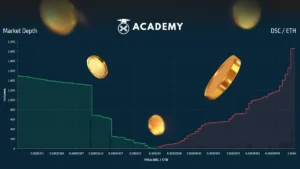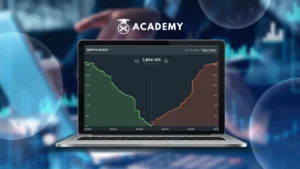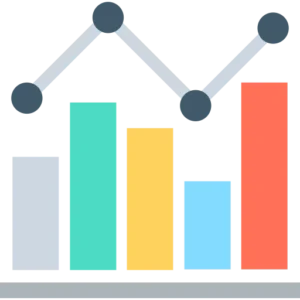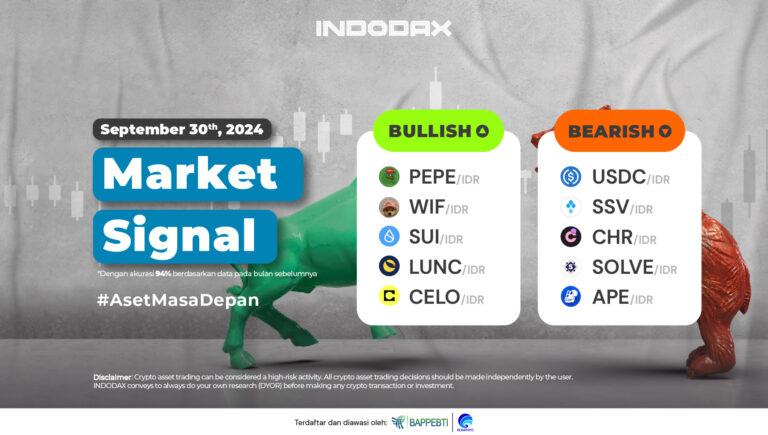In the world of trading, understanding market conditions is essential for making informed decisions and optimizing potential profits.
Without a deep understanding of market conditions, traders risk making poor decisions, which can result in financial losses.
In this regard, one important tool that traders can use is market depth.
Essentially, market depth is a tool that traders and investors can use to get a clearer picture of market liquidity and potential price movements.
To better understand what market depth is, from its uses, how it works, how to read it, to examples and applications in the industry, check out the following review.

What is Market Depth?
Market depth is a measure of the volume of limit orders in real-time. It indicates an exchange’s ability to execute a large number of orders without significantly affecting the price.
Market depth also serves as an indicator to measure the liquidity of a trading market. The greater the market depth, the more liquid the exchange is, and the less impact large orders have on market prices.
It also reduces the risk of price manipulation. Conversely, markets with low depth are more prone to price fluctuations.
What is Market Depth Used for?
Market depth provides traders and investors with valuable information about the supply and demand for a particular asset.
It shows the number of buy and sell orders at various price levels, helping market participants make informed decisions about when to buy or sell an asset.
In addition, market depth also helps understand the current state of the crypto market and predict potential price movements.
How does Market Depth Work?
Market depth is visualized through the order book, which is a real-time display of all outstanding buy and sell orders for a particular asset.
In the order book, buy orders are usually displayed on one side with their respective prices and quantities, while sell orders are displayed on the other side. Market depth is represented by the cumulative number of orders at various price levels.
The order book is constantly changing as new orders are placed and existing orders are filled. Traders use this information to gauge market sentiment.
For example, if there are more buy orders than sell orders at a certain price level then it indicates strong demand, potentially leading to a price increase.
Why is Market Depth Useful?
Basically, market depth serves several important purposes in trading and investing, including:
- Price Prediction: Traders can use market depth to predict potential support and resistance levels, which can help them determine entry and exit points for their trades.
- Liquidity Assessment: Market depth provides insight into market liquidity, allowing traders to assess how easily they can buy or sell a particular asset without significantly affecting its price.
- Risk Management: Understanding market depth helps traders manage risk and volatility by avoiding illiquid markets with wide bid-ask spreads.
How to Read Market Depth
The following are ways to read market depth that are important for traders and investors to understand, among others:
1. Understanding the Market Depth Table
Market depth tables usually display buy and sell orders at various price levels. Buy orders (bids) are generally located on one side, while sell orders (asks) are on the other. The number of bids and asks can give you an idea of buying and selling pressure.
2. Looking at Price Levels and Volume
Each price level in the market depth table shows the number of bids or asks available. The volume reflects how many units of an asset are willing to be bought or sold at a given price.
By comparing bid and ask volumes at the same price level, traders can get an idea of the balance between supply and demand.
3. Identifying Support and Resistance
Traders an monitor price levels with significant bid or ask volume. Levels with high bid volume are often support levels as many traders are ready to buy at those prices.
Conversely, levels with high ask volume often serve as resistance levels as many traders are ready to sell at those prices.
4. Looking at the Bid-Ask Spread
The bid-ask spread measures the difference between the highest price a buyer is willing to pay (bid) and the lowest price a seller is willing to accept (ask). This spread can provide information about market liquidity and volatility.
A narrow spread usually indicates good liquidity and low volatility, while a wide spread can signal poor liquidity and high volatility.
5. Analyzing Changes in Market Depth
Monitoring changes in market depth over time is also very important. If the number of bids increases significantly then it could indicate an increase in demand which could push prices up.
An increase in the number of asks could indicate an increase in supply which might cause prices to fall.
Importance of Understanding Market Depth
Understanding market depth is very important for traders as it provides an in-depth insight into market conditions. This information helps traders identify market trends, support and resistance levels, and potential changes in supply and demand dynamics.
By understanding market depth, traders can make more informed decisions about when to enter or exit trading positions. In addition, this understanding also helps in planning more effective risk management strategies.
Industry Examples and Applications
Market depth is an important concept in the financial industry that has been widely adopted on trading platforms and exchanges.
Crypto exchanges, stock markets, and commodity markets all provide market depth data to help traders and investors make more informed decisions.

Market Depth Example in Practice
Quoting the iinvestopedia.com page, consider the order book information in the image below, which displays the current bid-ask spread on the left, along with the market depth on the right. This type of quote is also known as level 2 market data.
Image source: Investopedia.com
The current quote for the security, MEOW stock, is $13.62-$13.68, with 3,000 shares on the bid side and 500 shares on the offer side. The right-hand panel shows the bid depth on the left.
If all 3,000 shares are sold at $13.62 then the next best bid is $13.45, but only for 16 shares.
If you had an order to sell 10,000 shares of MEOW in the market then you would sell all available bids up to a price of $13.35, at which point there is a pending order to buy 43,500 shares.
Selling 10,000 shares would move the market down almost 30 cents, or about 2%. That indicates a low level of market depth.
Conclusion
In conclusion, understanding market depth provides a number of significant benefits to traders and investors.
By knowing the depth of the market, they can gain deeper insights into supply and demand dynamics, identify support and resistance levels, and predict potential price movements.
This helps in making more informed trading decisions, better managing risks, and planning more effective strategies.
Furthermore, traders and investors are encouraged to utilize market depth in their trading strategies.
By understanding and utilizing market depth information, they can improve their ability to determine the right time to enter or exit a trading position, as well as optimize profit opportunities while minimizing risk.
Let’s Invest in Crypto on INDODAX
Now, you understand what market depth is, from its uses, how it works, how to read it, to examples and applications in the industry.
Furthermore, for those of you who are interested in making crypto investments easily, safely, and profitably, from buying bitcoin, buying ethereum,, to buying other crypto assets, you can buy them at INDODAX Market.
Please note, to facilitate crypto trading safely and easily, you can also download the best crypto application from INDODAX on the Google Play Store or via the App Store right now!
For information, INDODAX is a trusted and most popular crypto asset trading platform and is still the best to date in Indonesia.
With the support of more than 6.7 million members, INDODAX provides various types of crypto assets, including Bitcoin, Ethereum, Dogecoin, and other crypto assets.
Being a pioneer of buying and selling crypto assets in the country, INDODAX is always committed to providing easy access for investors to enter the crypto asset market.
As a disclaimer, it is important to remember that investing in crypto assets, like any other type of investment, involves risks. Some of the main risks include fluctuations in the value of cryptocurrencies and high levels of volatility in these assets.
Therefore, it is very important for traders and investors to do in-depth research before starting to invest in crypto assets.
So, let’s start investing in crypto assets right now on INDODAX!
FAQ
1. What is Market Depth?
Answer: Market Depth is a measure of the market’s ability to absorb large orders without significantly affecting prices, taking into account open buy and sell orders at various price levels.
2. How to read the Market Depth table?
Answer: The Market Depth table displays buy orders (bids) and sell orders (asks) at various price levels. Buy orders are displayed on one side with price and volume, while sell orders on the other. Comparing bid and ask volumes helps identify buying and selling pressure.
3. Why is Market Depth important in trading?
Answer: Market Depth is important because it helps traders predict support and resistance levels, assess market liquidity, and manage risk better, thus making more informed trading decisions.
4. How does Market Depth help in risk management?
Answer: By understanding Market Depth, traders can avoid illiquid markets and wide bid-ask spreads, which helps reduce risk and volatility in trading.
5. What is the difference between bid and ask in Market Depth?
Answer: Bid is the highest price a buyer is willing to pay, while ask is the lowest price a seller is willing to accept. The bid-ask spread, which is the difference between the bid and ask, indicates the liquidity and volatility of the market.





 Polkadot 9.00%
Polkadot 9.00%
 BNB 0.51%
BNB 0.51%
 Solana 4.77%
Solana 4.77%
 Ethereum 2.37%
Ethereum 2.37%
 Cardano 1.58%
Cardano 1.58%
 Polygon Ecosystem Token 2.11%
Polygon Ecosystem Token 2.11%
 Tron 2.85%
Tron 2.85%
 Market
Market


